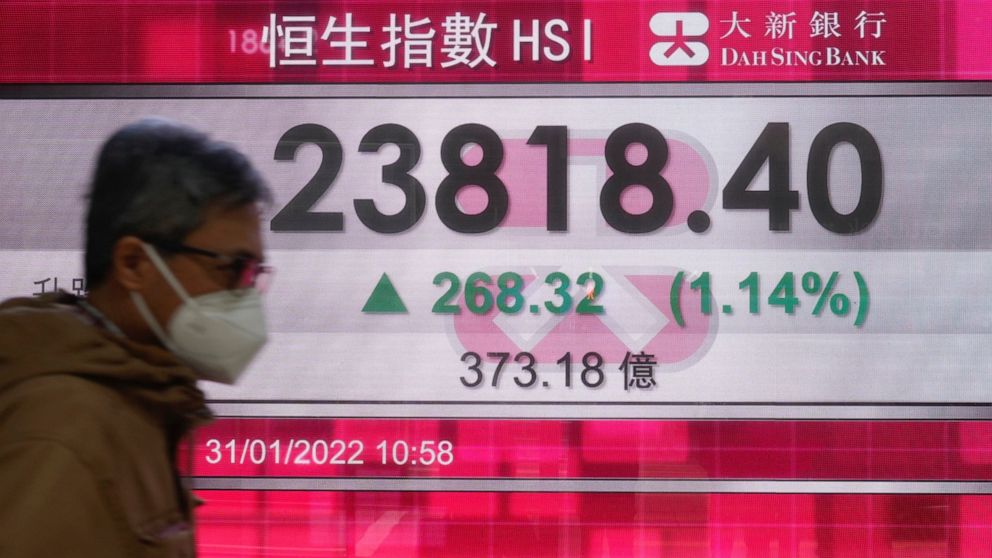Stocks mixed as Wall Street ends worst month since March ’20
Stocks are mixed Monday as Wall Street heads for its worst month since the early days of the pandemic, weighed by worries that imminent hikes in interest rates will make everything in markets more challenging
NEW YORK — Stocks are mixed Monday as Wall Street heads for its worst month since the early days of the pandemic, weighed by worries that imminent hikes in interest rates will make everything in markets more challenging.
The S&P 500 was drifting between small gains and losses in the first few minutes of trading and was most recently virtually unchanged from Friday. It’s down 7.5% since setting a record exactly four weeks ago and is on track for a loss of 7% this month. That would be its worst since falling 12.5% in March 2020, when it hit bottom after the pandemic suddenly shut down the global economy.
The Dow Jones Industrial Average was down 109 points, or 0.3%, at 34,615, as of 9:51 a.m. Eastern time, and the Nasdaq composite was 0.9% higher.
The losses have come as investors try to get ahead of a massive shift in markets, where the Federal Reserve is about to start withdrawing the tremendous stimulus it’s pumped into the economy and markets. The wide expectation is for the Fed to begin raising interest rates in March, among other moves to make borrowing money less easy.
The heaviest losses this month have hit parts of the stock market seen as the most expensive. Much of the focus has been on high-growth technology stocks, which were absolute stars of the pandemic amid expectations they’ll keep growing regardless of the economy. Tech stocks in the S&P 500 are down 8.9% this month, though they rose 0.5% Monday.
Any time the Fed raises rates, the stock market has historically had at least some difficulty adjusting. When bonds pay more in interest, investors feel less need to reach for stocks and other riskier investments in search of returns. This time, the Fed is also turning off what’s colloquially known as the “money printer” it’s been using to buy bonds to keep longer-term rates low, and it will likely soon remove some of those extra dollars sloshing around the economy.
The market may have an even tougher time than usual with this rate-hike campaign, because the Fed is going to be moving when growth for the economy and corporate earnings may be set to slow, say strategists at Morgan Stanley.
They pointed to what they see as worrying signs in data about U.S. manufacturing and in earnings expectations for some companies, among other factors.
“We remain sellers of rallies and of the view that S&P 500 fair value remains closer to 4,000 tactically,” the strategists led by Michael Wilson wrote in a report. The S&P 500 closed Friday at 4,431.85.
Others on Wall Street aren’t as pessimistic, though. That’s in large part due to broad expectations that corporate profits will continue to grow. For the full year of 2022, analysts are forecasting S&P 500 earnings will rise 9.5%, according to FactSet.
But markets have also been incredibly volatile in recent weeks amid uncertainty about just how quickly and how far the Fed will go. Early morning drops for stocks have quickly given way to sharp losses in the afternoon, and vice versa. On Friday, a sudden upturn in the last hour of trading managed to keep the S&P 500 from logging its fourth weekly loss in a row.
The uncertainty has built as investors ratchet up and down their expectations for how quickly and how sharply the Fed will move as it turns off “easy mode” for investors. Inflation is at its highest level in nearly 40 years, and the job market looks strong, which seemingly gives the Fed license to act aggressively.
Treasury yields climbed on Monday. The yield on the 10-year Treasury rose to 1.80% from 1.77% Friday. The two-year yield, which moves more on expectations about what the Fed will do with short-term rates, climbed to 1.20% from 1.15%.
———
AP Business Writer Joe McDonald contributed.
![]()


